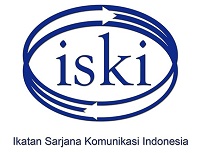The Role of Communication in Organizational Conflict Management at PT. Sinar Makmur Nusa Tenggara
Abstract
The sales team of PT. Sinar Makmur Timur, Nusa Tenggara area was formed in May 2019 and has been by the company standards in October 2019. In January 2020, the first conflict arose with the absence of the Sales Division during the morning briefing. Then the other conflicts have sprung up between the Sales Division and Area Sales Manager. This research focuses on the role of communication in organizational conflict management, especially the conflict between the Area Sales Manager and the Sales Division at PT. Sinar Makmur Timur Nusa Tenggara area. The approach to this research is a qualitative approach with a case study method. The results insulted that (1) the conflict is caused by the Sales Division which didn’t implement the Standard Operating Procedure (SOP). (2) The conflict resolution uses the team management style from R. Blake & Mouton, the collaborative style from Thomas & Kilmann conflict management, and the integrative negotiation. (3) Communication plays a role in conflict management at PT. Sinar Makmur Timur Nusa Tenggara as the conflict itself as well as a means of conflict resolution. (4) The organizational communication approach in PT. The Sinar Makmur Timur Nusa Tenggara area is a classic approach.
Keywords
Full Text:
PDFReferences
Anaomi. (2014). Strategi Komunikasi Persuasif Human Resources Development Dalam Menyelesaikan Konflik Karyawan Pt. Dimas Drillindo Cabang Duri Provinsi Riau. Jom Fisip, 1(2), 1–12.
Aula, P., & Siira, K. (2010). Organizational communication and conflict management systems: A social complexity approach. Nordicom Review, 31(1), 125–141. https://doi.org/10.1515/nor-2017-0125
Ayuningtyas, F., & Prihatiningsih, W. (2017). Komunikasi Terapeutik pada Lansia di Graha Werdha AUSSI Kusuma Lestari, Depok. Mediator: Jurnal Komunikasi, 10(2), 201–215. https://doi.org/10.29313/mediator.v10i2.2911
Cai, D. A., Fink, E. L., & Walker, C. B. (2019). Robert R. Blake, With Recognition of Jane S. Mouton. Negotiation and Conflict Management Research, 13(1), 1–9. https://doi.org/10.1111/ncmr.12151
Cho, K. W., Yi, S. H., & Choi, S. O. (2018). Does Blake and Mouton’s managerial grid work?: the relationship between leadership type and organization performance in South Korea. International Review of Public Administration, 23(2), 103–118. https://doi.org/10.1080/12294659.2018.1471029
Dani, A. K. (2016). Hubungan Komunikasi Organisasi dan Komitmen Manajemen Konflik pada Guru di Sekolah Islam Bunga Bangsa Samarinda. E-Jurnal Psikologi, 4(2), 189–199.
Haes, P. E., & Joniarta, I. W. (2020). Organization Communication: Internal Conflict In Hospitality Industri. Mediator: Jurnal Komunikasi, 13(2), 101–107. https://doi.org/https://doi.org/10.29313/mediator.v13i1.5636
Kim, H., Sefcik, J. S., & Bradway, C. (2017). Characteristics of Qualitative Descriptive Studies: A Systematic Review. Research in Nursing & Health, 40(1), 23–42. https://doi.org/10.1002/nur.21768.Characteristics
Kitana, A. (2016). Overview of the Managerial Thoughts and Theories From the History : Classical Management Theory to Modern Management Theory. Indian Journal of Management Science (Ijms), 6(1), 16–21.
Muhammad, A. (2014). Komunikasi Organisasi. Jakarta: Bumi Aksara.
Mukhtazar. (2020). Prosedur Penelitian Pendidikan. Jakarta: Absolute Media.
Nahar, L. (2014). Understanding of the Use of Blake & Mouton’s Model as a Tool for Analysing and Improving Management of Conflict in Organisations. International Journal of Research in Social Sciences, 4(4), 44–55.
Nicotera, A. M., & Mahon, M. M. (2012). Between Rocks and Hard Places: Exploring the Impact of Structurational Divergence in the Nursing Workplace. Management Communication Quarterly, 27(1), 90–120. https://doi.org/10.1177/0893318912458214
Omisore, B. O., & Abiodun, A. R. (2014). Organizational Conflicts: Causes, Effects, and Remedies. International Journal of Academic Research in Economics and Management Sciences, 3(6), 118–137. https://doi.org/10.6007/ijarems/v3-i6/1351
Onwuegbuzie, A. J., Leech, N. L., & Collins, K. M. T. (2012). Qualitative analysis techniques for the review of the literature. Qualitative Report, 17(56), 1–28.
Pace, W., & Faules, D. F. (2015). Komunikasi Organisasi: Strategi Meningkatkan Kinerja Perusahaan. Bandung: Remaja Rosdakarya.
Riasi, A., & Asadzadeh, N. (2015). The relationship between principals’ reward power and their conflict management styles based on Thomas–Kilmann conflict mode instrument. Management Science Letters, 5(6), 611–618. https://doi.org/10.5267/j.msl.2015.4.004
Romadhan, M. I. (2018). Pendekatan Komunikasi Organisasi Dalam Penyampaian Kebijakan Kantin Bebas 5P (Pewarna, Penyedap, Pemanis, Pengawet, dan Perasa) di SMP Negeri 7 Surabaya. Jurnal Riset Komunikasi, 1(2), 254–263. https://doi.org/10.24329/jurkom.v1i2.38
Rubino. (2019). Konseptualisasi Mekanistis dalam Perspektif Komunikasi. Hikmah, 13(1), 134–150. https://doi.org/https://doi.org/10.24952/hik.v13i1.1336
Safitri, R., Burhan, O. K., & Zulkarnain. (2013). Gaya Manajemen Konflik dan Kepribadian. Psikologia: Jurnal Pemikiran Dan Penelitian Psikologi, 8(2), 39–49. https://doi.org/10.32734/psikologia.v8i2.6576
Stoshikj, M. (2014). Integrative and distributive negotiations and negotiation behavior. Journal of Service Science Research, 6(1), 29–69. https://doi.org/10.1007/s12927-014-0002-8
Trudel, J., & Reio, T. (2011). Managing Workplace Incivility: The Role of Conflict Management Styles - Antecedent or Antidote? Human Resources Development Quarterly, 22(4), 395–423. https://doi.org/https://doi.org/10.1002/hrdq.20081
Wirawan. (2010). Konflik dan Manajemen Konflik: Teori, Aplikasi, dan Penelitian. Jakarta: Salemba Humanika.
Yuningsih, A. (2011). Implementasi Komunikasi Organisasi dalam Manajemen Konflik. Jurnal Sosial, Ekonomi, Dan Humaniora, 2(1), 195–202.
DOI: https://doi.org/10.29313/mediator.v13i2.6094
Refbacks
- There are currently no refbacks.

This work is licensed under a Creative Commons Attribution 4.0 International License























